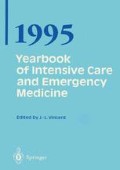Abstract
The incorporation of microprocessors into the design of ventilators has produced a confounding array of products, each with its own peculiar features and modes of operation. This confusion has been compounded in the medical literature with unproved statements favoring one new device or mode of ventilation over another. We believe that physicians concerned with the ventilatory management of patients with respiratory failure must base their approach on physiologic principles and an understanding of patient-ventilator interactions [1].
Access this chapter
Tax calculation will be finalised at checkout
Purchases are for personal use only
Preview
Unable to display preview. Download preview PDF.
References
Hubmayer RD, Abel MD, Rehder K (1990) Physiologic approach to mechanical ventilation. Crit Care Med 18: 103–113
American Association for Respiratory Care (1992) Consensus statement on the essentials of a mechanical ventilator. Respir Care 37: 1000–1008
Sassoon CSH (1992) Mechanical ventilator design and function: The trigger variable. Respir Care 37: 1056–1068
Chatburn RL (1991) A new system for understanding mechanical ventilators. Respir Care 36: 1123–1155
Viale JP, Annat G, Bertrand O, et al (1985) Additional inspiratory work in intubated patients breathing with continous positive pressure systems. Anesthesiology 63: 536–539
Beyond L, Chasse M, Harf A, et al (1988) Inspiratory work of breathing during spontaneous ventilation using demand valves and continuous flow system. Am Rev Respir Dis 138: 300–304
Sassoon CSH, Giron AE, Ely EA, et al (1989) Inspiratory work of breathing on flow by and demand flow continous positive airway pressure. Crit Care Med 17: 1108–1114
Sassoon CSH, Light RW, Lodia R, et al (1991) Pressure-time product during continous positive airway pressure, pressure support ventilation, and T-piece during weaning from mechanical ventilation. Am Rev Respir Dis 143: 469–475
Sassoon CSH, Lodia R, Rheeman CH, et al (1992) Inspiratory muscle work of breathing during flow by, demand flow, and continous flow systems in patients with chronic obstructive pulmonary disease. Am Rev Respir Dis 145: 1219–1222
Henry WC, West GA, Wilson RS (1983) A comparison of the cost of breathing between a continous flow CPAP system and a demand flow CPAP system. Respir Care 28: 1273–1281
Giuliani R, Mascia L, VM Ranieri (1995) Patient-ventilator interaction during SIMV: Effects of flow triggering. Am J Respir and Crit Care Med (in press)
Ranieri VM, Mascia L, Giuliani R (1995) Inspiratory effort and measurement of dynamic intrinsic PEEP in COPD patients: Effects of ventilator triggering systems (in press)
Smith TC, Marini JJ (1988) Impact of PEEP on lung mechanics and work of breathing in severe airway obstruction. J Appl Physiol 65: 1488–1499
Petrof BJ, Legaré M, Goldberg P, et al (1990) Continous positive airway pressure reduces work of breathing and dyspnea during weaning from mechanical ventilation in severe chronic obstructive pulmonary disease. Am Rev Respir Dis 141: 281–289
Marini JJ (1989) Should PEEP be used in airflow obstruction? Am Rev Respir Dis 140: 1–3
Tobin MJ, Perez W, Guenther SM, et al (1986) The pattern of breathing during successful and unsuccessful trials of weaning from mechanical ventilation. Am Rev Respir Dis 134: 1111–1118
Appendini L, Patessio L, Zanaboni, et al (1994) Physiologic effects of positive end-expiratory pressure and mask pressure support during exacerbations of chronic obstructive pulmonary disease. Am J Respir Crit Care Med 149: 1069–1076
Marini JJ, Rodriguez RM, Lamb V (1986) The inspiratory workload of patient-initiated mechanical ventilation. Am Rev Respir Dis 134: 902–909
Marini JJ, Capps JS, Culver BH (1985) The inspiratory work of breathing during assisted mechanical ventilation. Chest 87: 612–618
Ward ME, Corbeil C, Gibbson W, et al (1988) Optimization of respiratory muscle relaxation during mechanical ventilation. Anesthesiology 69: 29–35
Younes M (1992) Proportional assist ventilation, a new aproach to ventilator support: Part I. Theory. Am Rev Respir Dis 145: 114–120
Younes M, Puddy A, Roberts D, et al (1992) Proportional assist ventilation: Results of an initial clinical trial. Am Rev Respir Dis 145: 121–129
Mascia L, Caracciolo A, Ranieri M (1994) Pressure support ventilation (PSV) vs proportional assist ventilation (PAV): Effects of changes in respiratory drive. Intensive Care Med 20: S51 (Abst)
Editor information
Editors and Affiliations
Rights and permissions
Copyright information
© 1995 Springer-Verlag Berlin Heidelberg
About this paper
Cite this paper
Ranieri, V.M., Mascia, L., Giuliani, R. (1995). Patient-Ventilator Interaction: Physiology of the Triggering Function. In: Vincent, JL. (eds) Yearbook of Intensive Care and Emergency Medicine. Yearbook of Intensive Care and Emergency Medicine, vol 1995. Springer, Berlin, Heidelberg. https://doi.org/10.1007/978-3-642-79154-3_10
Download citation
DOI: https://doi.org/10.1007/978-3-642-79154-3_10
Publisher Name: Springer, Berlin, Heidelberg
Print ISBN: 978-3-540-58256-4
Online ISBN: 978-3-642-79154-3
eBook Packages: Springer Book Archive

